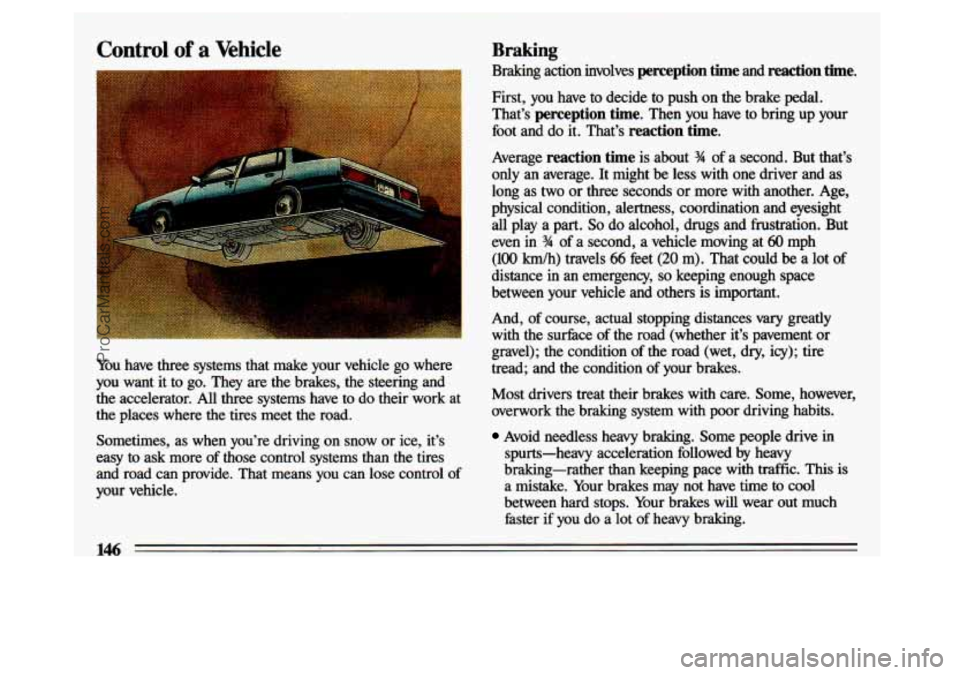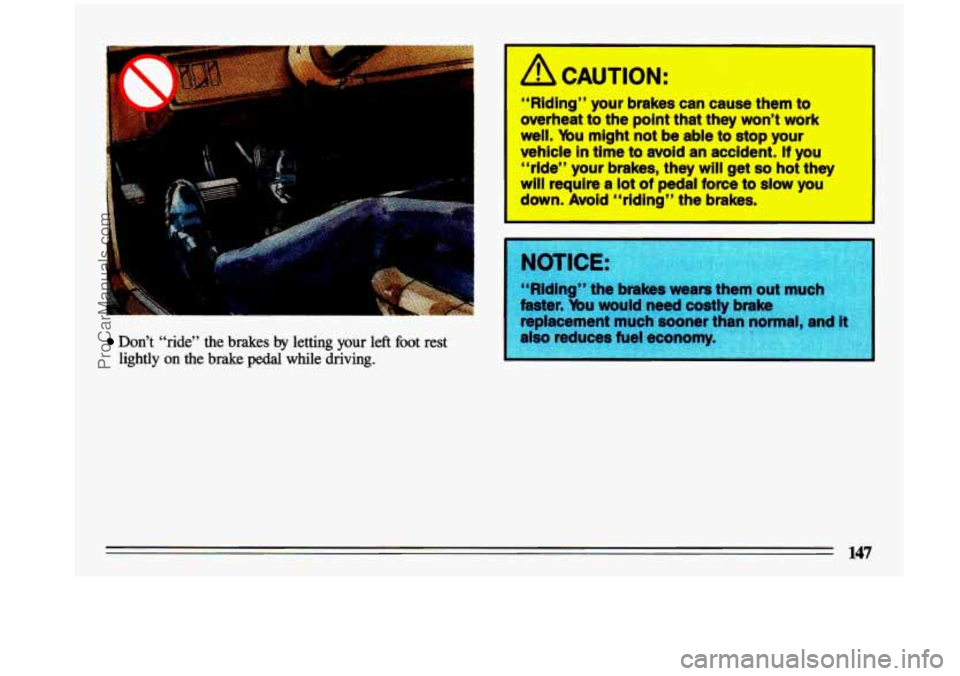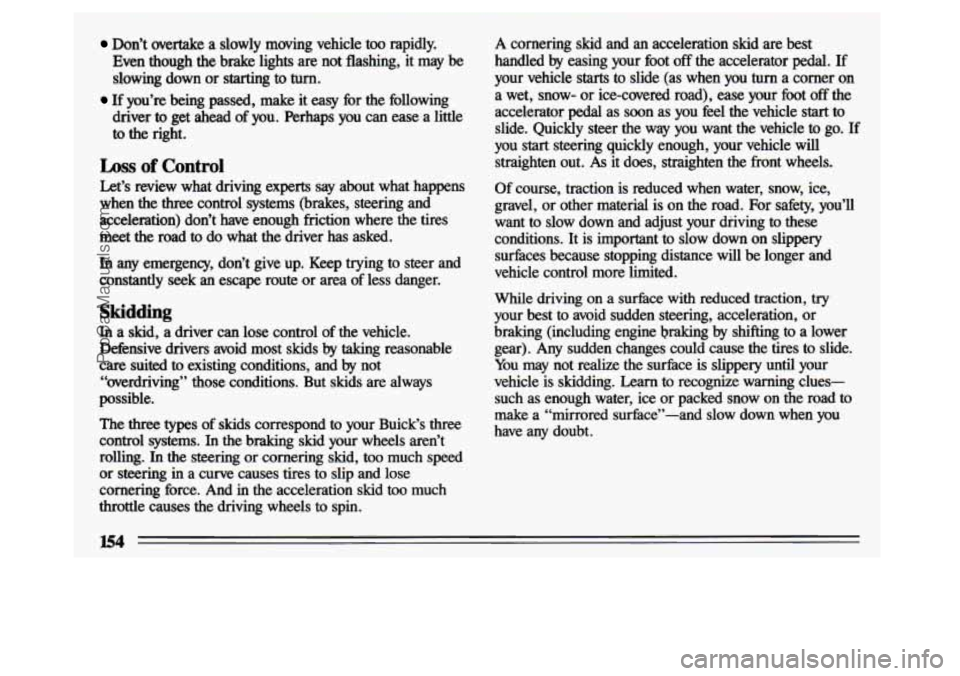1993 BUICK CENTURY brake
[x] Cancel search: brakePage 144 of 324

If necessary, you can use hand signals out the window:
Left arm straight out for a left turn, down for slow or
about-to-stop, and up
for a right turn.
Slowing down. If time allows, tap the brake pedal once
or twice in advance of slowing
or stopping. This warns
the driver behind you.
Disabled. Your four-way flashers signal that your vehicle
is disabled or is a hazard.
See “Hazard Warning
Flashers’’ in the Index.
Traffic Officer
The traffic police officer is also a source of important
information. The officer’s signals govern, no matter what
the traffic lights or other signs say.
The next section discusses some
of the road conditions
you may encounter.
Defensive Driving
The best advice anyone can give about driving is: Drive
defensively.
Please
start with a very important sakty device in your Buick:
Buckle up.
(See “Safety Belts” in the Index.)
Defensive driving really means “be ready for anything:’
On city streets, rural roads, or freeways, it means
“always expect the unexpected:’ Assume that pedestrians
or other drivers are going to be
careless and make mistakes. Anticipate what they might
do. Be ready for their mistakes.
Expect children to dash out from behind parked cars,
often followed by other children. Expect occupants in
parked cars to open doors into traffic. Watch for movement
in parked cars-someone may be about to open
a door.
Expect other drivers to run stop signs when you are on a
through street. Be ready to brake
if necessary as you go
through intersections. You may not have to use the brake,
but if you do, you will be ready.
If you’re driving through a shopping center parking lot
where there are well-marked lanes, directional mows,
and designated parking areas, expect some drivers to
ignore
all these markings and dash straight toward one
part of the lot.
Pedestrians can be careless. Watch for them. In general,
you must give way to pedestrians even if you
know you
have the right of way.
Rear-end collisions
are about the most preventable of
accidents. Yet they are common. Allow enough following
distance. It’s the best defensive driving maneuver, in both
city and rural driving. You never know when the vehicle
in front of you is going
to brake or turn suddenly.
Here’s a final bit of information about defensive driving.
The most dangerous time for driving in the
U.S. is very
142
ProCarManuals.com
Page 148 of 324

You have three systems that make your vehicle go where
you want it to go. They are the brakes, the steering and
the accelerator.
All three systems have to do their work at
the places where the tires meet the road.
Sometimes, as when you’re driving on snow
or ice, it’s
easy to ask more of those control systems than the tires
and road can provide. That means you can lose control of
your vehicle.
Braking
Braking action involves perception time and reaction time.
First, you have to decide to push on the brake pedal.
That’s
perception time. Then you have to bring up your
foot and do it. That’s
reaction time.
Average reaction time is about 34 of a second. But that’s
only
an average. It might be less with one driver and as
long as
two or three seconds or more with another. Age,
physical condition, alertness, coordination and eyesight
all play a part.
So do alcohol, drugs and frustration. But
even in
% of a second, a vehicle moving at 60 mph
(100 ludh) travels 66 feet (20 m). That could be a lot of
distance
in an emergency, so keeping enough space
between your vehicle and others is important.
And, of course, actual stopping distances vary greatly
with the surf$ce of the road (whether it’s pavement or
gravel); the condition of the road (wet, dry, icy); tire
tread; and the condition of your brakes.
Most drivers treat their brakes with care. Some, however,
overwork the braking
system with poor driving habits.
Avoid needless heavy braking. Some people drive in
spurts-heavy acceleration followed
by heavy
braking-rather than keeping pace with traffic.
This is
a mistake. Your brakes may not have time to cool
between hard stops. Your brakes
will wear out much
faster
if you do a lot of heavy braking.
146
ProCarManuals.com
Page 149 of 324

Don’t “ride” the brakes by letting your left foot rest
lightly
on the brake pedal while driving.
“Riding” your brakes can cause them to
overheat to the pointthat they won’t work
well. Mu might not be able to stop your
vehicle In tlme to avoid an accident. If you
6crlde” your brakes, they will get 80 hot they
will require a lot of pedal force to slow you
down. Avold “ridlng” the hralaas.
faster. vou would need cos
replacement
much sooner
also reduces fuel economy.
147
ProCarManuals.com
Page 150 of 324

If you keep pace with the traffic and allow realistic
following distances, you
will eliminate a lot of
unnecessary braking. That means better braking and
longer brake life.
If your engine ever stops while you're driving, brake
normally but don't pump your brakes. If you do, the
pedal may get harder
to push down. If your engine
stops, you will still have some power brake assist. But
you will use it when
you brake. Once the power assist
is used up, it may take longer to stop and the brake
pedal will be harder to push.
Disc Brake Wear Indicators
Your Buick has front disc brakes and rear drum brakes.
I A CAUTION:
The brake wear wamlng sound means that
sooner or later pur brakes won't work well.
That could lead to an accident. When you hear
the brake wear warning sound, have your
vehlcle serviced.
I
Disc brake pads have built-in wear indicators that make a
high-pitched warning sound when the brake pads are Some driving conditions or climates may cause a brake
worn and new pads
are needed. The sound may come squeal when the brakes are first applied or lightly
and
go or be heard all the time your vehicle is moving applied. This do\
es not mean something is wrong with
(except when you are pushing on the brake pedal firmly). your brakes.
ProCarManuals.com
Page 151 of 324

Rear Drum Brakes
Your rear drum brakes don’t have wear indicators, but if
you ever hear a rear brake rubbing noise, have the rear
brake linings inspected.
Also, the rear brake drums should
be removed and inspected each time the tires are removed
for rotation or changing. .When you have the front brakes
replaced, have the rear brakes inspected, too.
Brake linings should always be replaced as complete
axle sets.
Braking In Emergencies
At some time, nearly every driver gets into a situation
that requires hard braking. Your first reaction-to
hit the
brake
pedal hard and hold it down-may be the wrong
thing to do. Your wheels can stop rolling. Once they
do,
the vehicle can’t respond to your steering. Momentum
will carry it
in whatever direction it was headed when the
wheels stopped rolling. That could be
off the road, into
the very thing you were trying
to avoid, or into traffic.
Use a “squeeze” braking technique. This will give you
maximum braking while maintaining steering control.
You do
this by pushing on the brake pedal with steadily
increasing pressure.
Brake Pedal Travel
See your dealer if the brake pedal does not return to
normal height, or if there is a rapid increase in
pedal
travel. This could be a sign of brake trouble.
Brake Adjustment
Every time you make a moderate brake stop, your disc
brakes adjust for wear.
If you rarely make a moderate or
heavier stop, then your brakes might not adjust correctly.’
If you drive in that way, then-very carefully-make a
few moderate brake stops about every
1,0oO miles
(1 600 km), so your brakes will adjust properly.
If your brake pedal goes down farther than normal, your rear drum brakes may need adjustment. Adjust them by
backing up and
firmly applying the brakes a few times. In an emergency you will probably want
to “squeeze”
the
brakes hard without locking the wheels.
If you hear or
feel the wheels sliding, ease off the brake pedal. This will
help you retain steering control.
In many emergencies, steering can help you more than
even the very best braking.
149
ProCarManuals.com
Page 152 of 324

Steering
Power Steering
If you lose power steering assist because the engine stops
or the system
fails to function, you can steer but it will
take much more effort.
Steering Tips
Driving on Curves
It’s important to take curves at a reasonable speed.
A lot of the “driver lost control” accidents mentioned on
the news happen on curves. Here’s why:
Experienced driver or beginner, each of us is subject to
the same laws of physics when driving on curves. The
traction
of the tires against the road surface makes it
possible for the vehicle to change its path when you turn
the front wheels. If there’s no traction, inertia will keep
the vehicle going
in the same direction. If you’ve ever
tried to steer a vehicle on wet ice, you’ll understand
this.
The traction you can get in a curve depends on the
condition
of your tires and the road surhce, the angle at
which the curve is banked, and your
speed. While you’re
in a curve, speed is the one factor you can control.
Suppose you’re steering through
a sharp curve. Then you
suddenly apply
the brakes. Both control systems-
steering and braking-have
to do their work where the
tires meet the road. Adding the hard braking can demand
too much at those places. You can lose control.
The
same thing can happen if you’re steering through a’
sharp curve and you suddenly accelerate. Those two
control systems-steering and acceleration-can
overwhelm those places where the tires meet the road and make you lose ‘control.
What should you do
if this ever happens? Let up on the
brake or accelerator
pedal, steer the vehicle the way you
want it to go, and slow down.
Speed limit signs near curves warn that you should adjust
your
speed. Of course, the posted speeds are based on
good weather and road conditions. Under less favorable
conditions you’ll want
to go slower.
If you need to reduce your speed as you approach a
curve, do it before you enter the curve, while your front
wheels
are straight ahead. Try to adjust your speed so
you can “drive” through the curve. Maintain a
reasonable, steady speed. Wait to accelerate until you are
out of the curve, and then accelerate gently into the
straightaway.
When you drive
into a curve at night, it’s harder to see
the road ahead of you because it bends away .from the
straight beams of your lights.
This is one good reason to
drive slower.
ProCarManuals.com
Page 153 of 324

Steering in Emergencies
There are times when steering can be more effective than
braking. For example, you come over a hill and find a
truck stopped in your lane, or a car suddenly pulls out
from nowhere, or a child darts out from between parked
cars and stops right in front of you. You can avoid these
problems
by braking-if you can stop in time. But
sometimes you can’t; there isn’t room. That’s the time for
evasive action-steering around the problem. Your Buick
can perform very well in emergencies like
these. First apply your brakes, but not enough to lock
your wheels.
It is better to remove as much speed as you
can from a possible collision. Then steer around the
problem, to the
left or right depending on the space
available.
An emergency like this requires close attention and a
quick decision. If you are holding the steering wheel at
the recommended
9’ and 3 o’clock positions, you can turn
it a full
180 degrees very quickly without removing either
hand. But you have to act fast, steer quickly, and just as
quickly straighten the wheel once you have avoided the
object. You must then be prepared to steer back to your
original lane and then brake to
a controlled stop.
Depending on your speed,
this can be rather violent for
an unprepared driver. This is one of the reasons driving
experts recommend that you use your safety belts and
keep both hands on the steering wheel.
The fact that such emergency situations are always
possible is a good reason to practice defensive driving at all times.
151
ProCarManuals.com
Page 156 of 324

Don’t overtake a slowly moving vehicle too rapidly.
Even though the brake lights are not flashing, it
may be
slowing down or starting to turn.
driver to get ahead of you. Perhaps you can ease a little
to the right.
If you’re being passed, make it easy for the following
Loss of Control
Let’s review what driving experts say about what happens
when the three control systems (brakes, steering and
acceleration) don’t have enough friction where the tires
meet the road
to do what the driver has asked.
In any emergency, don’t give up. Keep trying to steer and
constantly
seek an escape route or area of less danger.
Skidding
In a skid, a driver can lose control of the vehicle.
Defensive drivers avoid most skids
by taking reasonable
care suited
to existing conditions, and by not
“overdriving” those conditions. But skids are always
possible.
The three types
of skids correspond to your Buick‘s three
control systems. In the braking skid your wheels aren’t
rolling.
In the steering or cornering skid, too much speed
or steering in a curve causes tires to slip and lose
cornering force. And
in the acceleration skid too much
throttle causes the driving wheels to spin.
I
A cornering skid and an acceleration skid are best
handled by easing your foot
off the accelerator pedal. If
your vehicle starts to slide (as when you turn a corner on
a wet, snow- or ice-covered road), ease your
foot off the
accelerator pedal as soon as you feel the vehicle start to
slide. Quickly steer the way you want the vehicle to go. If
you
start steering quickly enough, your vehicle will
straighten out. As it does, straighten the front wheels.
Of course, traction is reduced when water, snow, ice,
gravel, or other material is on the road.
For safety, you’ll
want to slow down and adjust your driving
to these
conditions. It is important to slow down on slippery
surfaces because stopping distance will be longer and
vehicle control more limited.
While driving on a surfhce
with reduced traction, try
your best to avoid sudden steering, acceleration, or
braking (including engine braking
by shifting to a lower
gear).
Any sudden changes could cause the tires to slide.
You may not realize the surface is slippery until your
vehicle is skidding.
Learn to recognize warning clues-
such as enough water, ice or packed snow on the road
to
make a “mirrored surface”-and slow down when you
have
any doubt.
154
ProCarManuals.com